CHAPTER 15
CITRINE QUARTZ
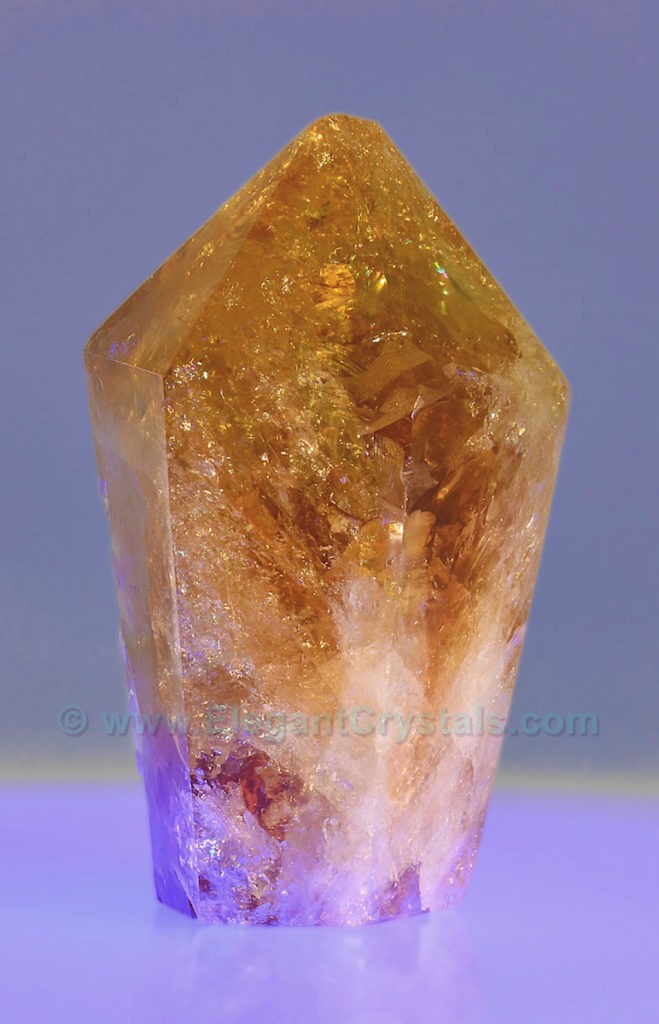
Picture #98
Four-inch-tall Polished Heat-treated Citrine from Brazil
Have you ever seen a citrine crystal like this?
It is about four inches tall with completely polished facets and base.
Most people have seen orange citrine crystals either as gemstones, single points or complicated clusters.
There are even orange stalactite pieces found as complex groups.
Did you know that this kind of crystal starts life as a pale amethyst color?
While deeply colored amethyst stones are highly treasured, the pale ones do not hold as much interest for many collectors.
The miners in Brazil discovered that by heating the crystals up to 500°F, the stones would permanently change their colors overnight.
They would take amethyst points, clusters and stalactites and pack them in wet leaves inside an oil drum or a big metal wheelbarrow.
The containers are heated over a wood fire.
It takes a day or two for the crystals to slowly cool down.
Wet leaves or wet sand around the crystals spread out the heat and help protect the stones.
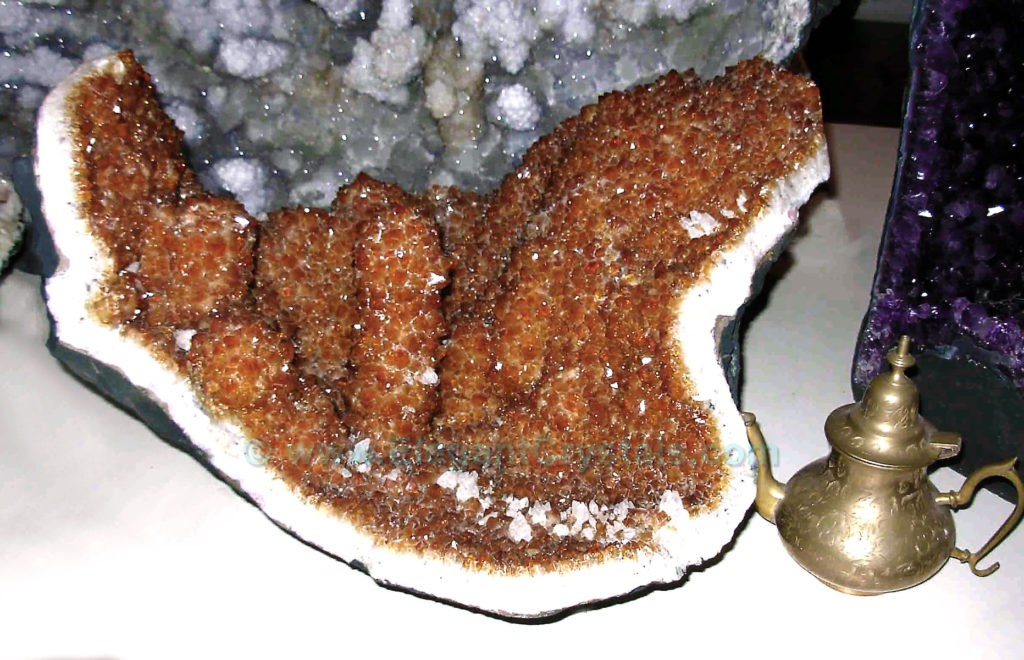
Picture #99
Two-foot-wide Heated Citrine Cluster with Stalactites
What does this heating process do to the spiritual energy of the stone?
Over the years, I have developed a degree of sensitivity to crystal energy.
Through my hands, fingertips and palms, I can sense different “flavors” of energy from various crystals.
When I hold these heat-treated citrines, also called “cooked citrines,” I can feel a memory of the warmth that the crystals absorbed during their magical color change.
These are great stones to use as a source of physical power, especially when held or directed at the solar plexus chakra (located just above the belly-button.)
I feel that the heat-treated stones also echo a memory of the molten temperatures surrounding them as they originally formed.
The heat treatment is a minor reflection of the extreme conditions that the crystals experienced in their distant past.
Occasionally, naturally heated cooked citrines are found in the ground.
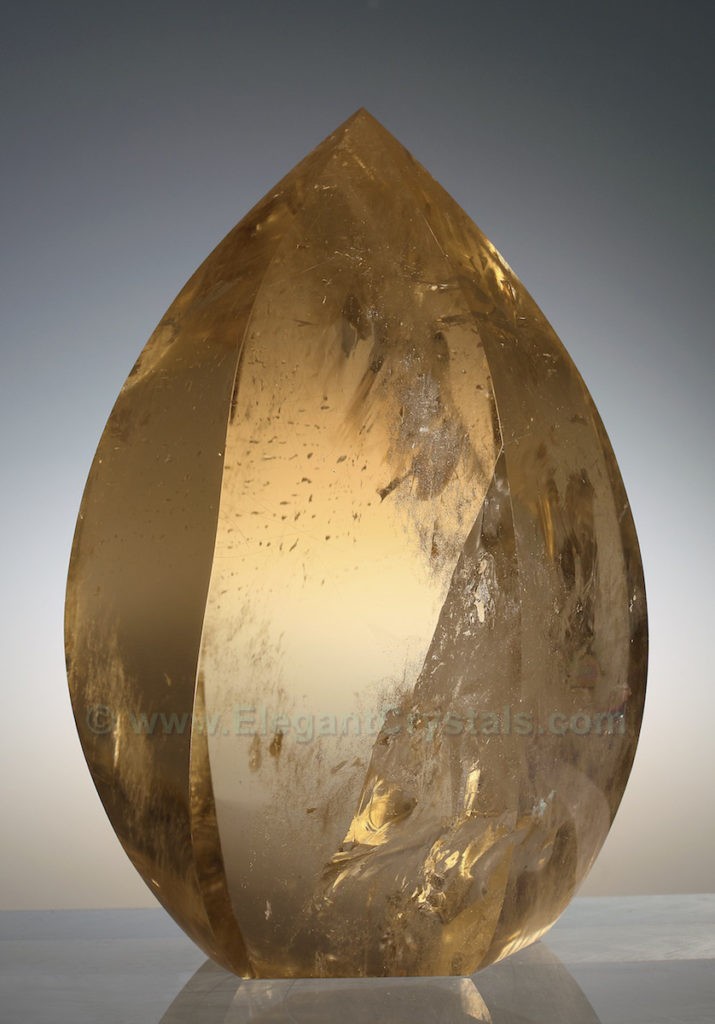
Picture #100
6-inch-tall Polished Brazilian Citrine
Natural citrine crystals occur in all the warm colors of the spectrum.
What will you find in your treasure hunt?
Lemon citrine
Champagne citrine
Yellow citrine
Light gold citrine
Dark gold citrine
Green citrine
Amethyst citrine
Smoky citrine
Black citrine
Every crystal has a unique color.
It is possible that two crystals growing next to each other in the ground may exhibit dramatically different color schemes.
Within one crystal, the colors may vary from area to area or in alternating zones or layers.
Amethyst citrine, known “as ametrine,” is a famous example.
We’ll see some dramatic ametrine photos soon.
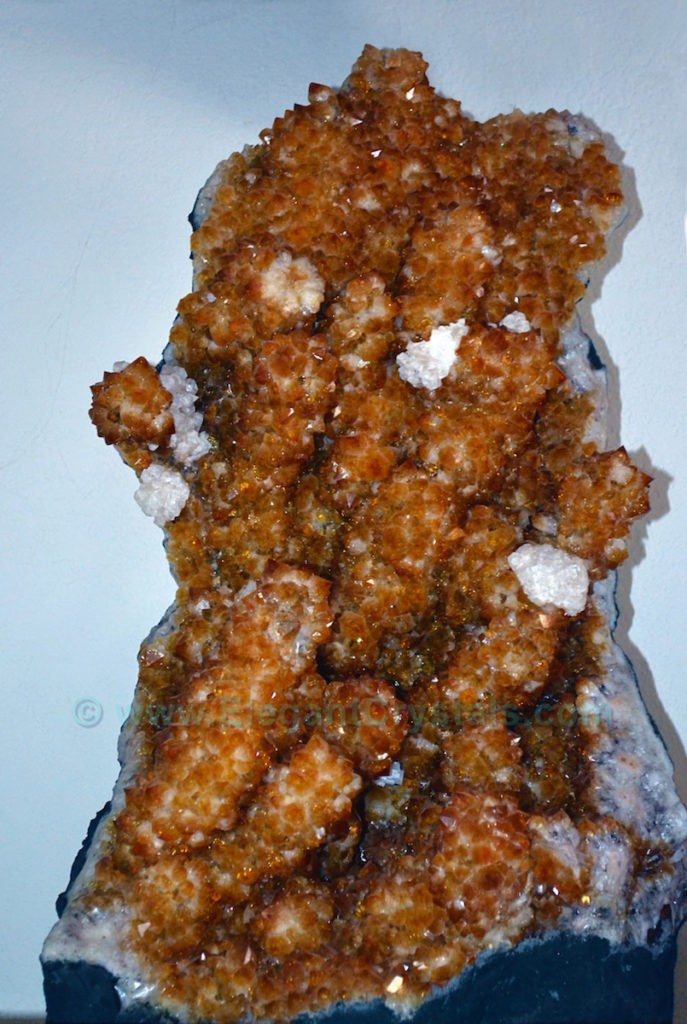
Picture #101
130-pound Heat-treated Citrine Cluster with Stalactites
Here is a beautiful example of color changes in crystals that formed as stalactites in a large geode.
The piece weighs about 130 pounds and undoubtedly came from a geode weighing close to a ton.
When amethyst crystals are heated up and then cooled into citrine colors, there may be some cracking and separation between the crystals.
When I purchase a piece like this, I go over all the junctions where the little crystals meet with thin beads of superglue.
Then the base of each stalactite column is reinforced with museum-grade conservator’s epoxy where it meets the matrix.
In this way, I can be assured that the crystals will not separate or break while the piece is being moved during shipping.
The orange or gold color in natural citrine or heat-treated stones is caused by a complex interaction of microscopic iron, manganese and other trace elements embedded in the quartz structure.
As the iron is “burned” in the heat treatment, the stone changes color states from purple to orange.
If it is heated too much, the stone will turn brown or sometimes black.
One researcher has experimented with heat-treated citrine by exposing it to x-rays and turning it back into purple amethyst!
X-rays are usually fairly dangerous, so folks, do not try this at home.
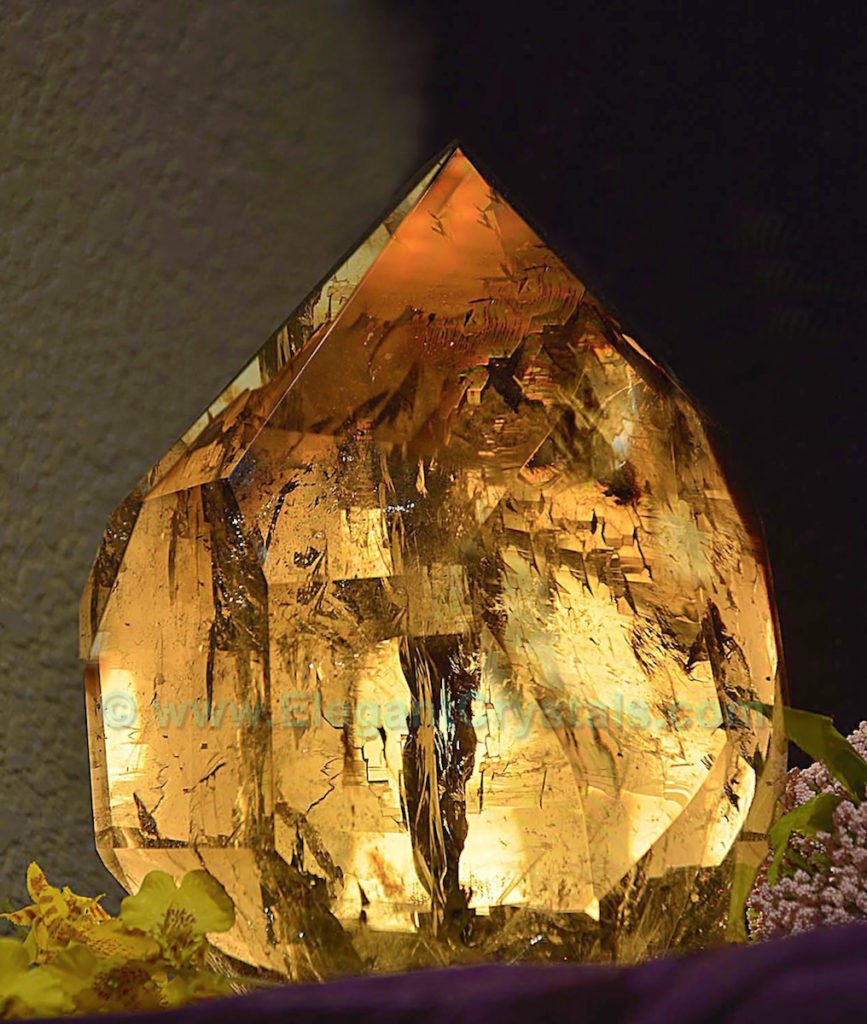
Picture #102
10-inch-tall Partially Polished Brazilian Gold Citrine Quartz
The carved golden flame shape shown above is almost 10 inches tall.
It was created from a naturally colored, vivid Brazilian citrine quartz crystal.
Unlike the orange heat-treated stones, this is a natural color that waited millions of years to be unearthed.
Depending on how the stone is lit for display, it may appear yellow, gold, orange or whiskey brown.
Citrines are especially responsive to delicate lighting.
If you take a yellow crystal outdoors on a sunny day, the sunlight will cancel out the warm glow because of the blue tint of the sky.
Now your citrine may look more like a smoky crystal.
This is the primary reason why some stones are called “smoky citrine.”
Remember that the light on the stone affects its color, especially when the light is coming through the back of the stone.
In this image, I have a small lamp with a 40-watt bulb shining straight through the back of the crystal.
It shows every detail inside the stone, including the full range of colors.
These stones can also be illuminated from underneath as you will see in the next series of photographs.

Picture #103
9-inch-tall Polished Brazilian Citrine Quartz on Light-box
Here is another Brazilian citrine flame sculpture.
It rests upon a walnut wood light-box that we built specifically for crystal displays with low powered lighting.
The stone is a very light, clear-gold color which looks much deeper when it is lighted from underneath.
As the light passes through deeper layers in the stone, the colors become more intense.
You can see how the light is focused up into the tip of the flame-shaped point where it takes on a vivid hue.
Inside this beautifully polished sculpture, we find a series of little cracks formed by pressure or heat changes during the growth of the crystal.
These “fissure” cracks could be considered “defects” in the atomic matrix.
These imperfections reflect, refract and diffract light into holographic patterns.
The result is extraordinarily detailed shapes and colors of everchanging iridescent light.
This rainbow phenomenon is similar to the thin-film colors found in soap bubbles and oil spills on water.
It is called the Schliemann Effect.
Rainbow images inside this particular stone are all tinted with golden light.
These next four pictures show a group of iris rainbows positioned under the facets of this citrine flame sculpture.
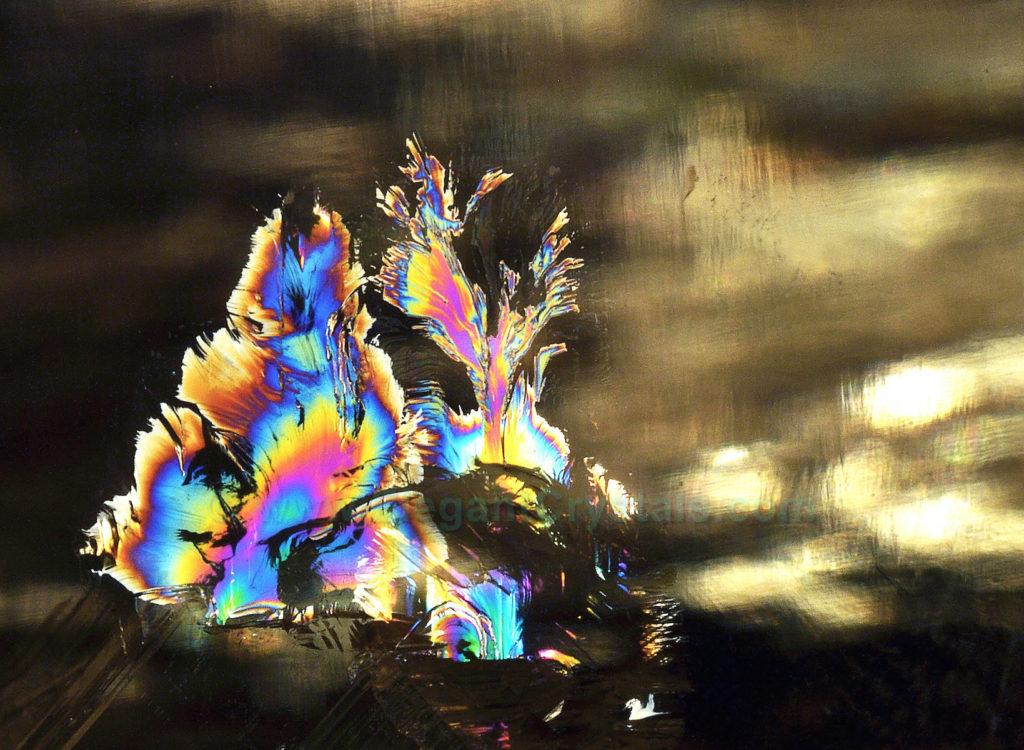
Picture #104
1/4-inch Iris Rainbow in Citrine Quartz
At 1/4-inch-wide, this tiny rainbow takes on hypnotically evocative shapes.
The extraordinary fractal beauty is minutely detailed at any magnification.
The background shows light reflecting off another distant fissure.
The silvery reflection is tinted gold by the citrine’s hue.
Typically, iris rainbows will range from 1/4 inch through two inches wide.
As you hold a rainbow crystal and turn it, the rainbows will fade into a shimmer of silvery light that almost entirely disappears when seen on edge.
The tiny cracks that create the colors may be 1/1,000 of an inch wide, down to 1/30,000 of an inch.
The gap size determines the various colors that are created from the fissure.
In my three rainbow books, you can meet dozens of rainbow phenomena.
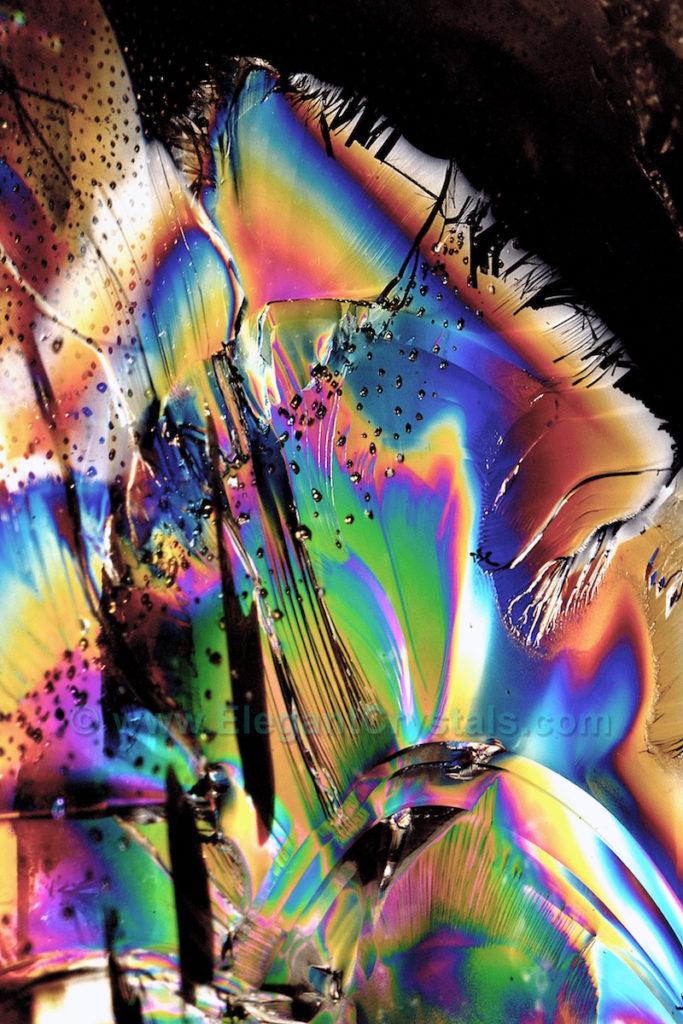
Picture #105
Iris Rainbow in Citrine Quartz
Here is a different rainbow in the same crystal.
This rainbow display is almost two inches wide.
It was complex enough to yield dozens of delicately colored pictures in vivid hues.
The color spectrum in quartz is different from the colors that we see in a sky rainbow.
Both types of rainbows exhibit a complex interaction of light rays that create the intense colors.
All the crystal rainbows are highly dependent on the angle of view.
The colors constantly shift as the stone is rotated.
There is a layer of little points showing as dark dots slightly above the rainbow.
Upon close examination, we can see that each of the dark dots is a shadow of a tiny crystal.
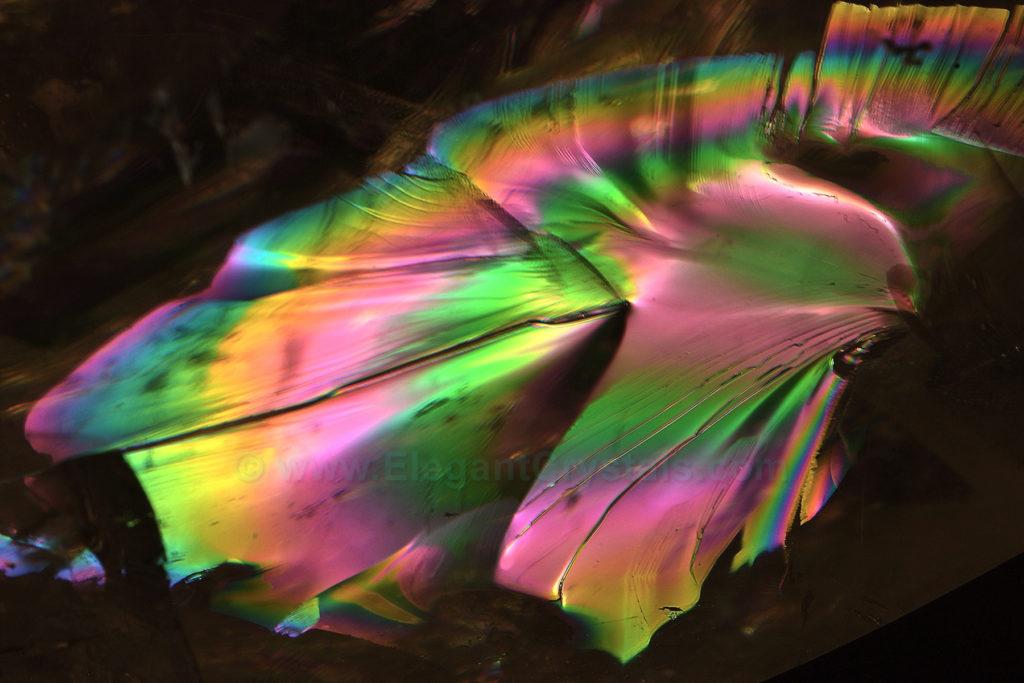
Picture #106
Iris Rainbow in Citrine Quartz
This image shows a complete rainbow system with crisply bounded edges floating inside the citrine quartz.
The gold citrine changes the tints of all the colors that come from the iris rainbows.
Fissures in quartz typically show concentric bands of radiating colors in different degrees of luminosity and tone.
The fractal shapes and colors that form these displays are reminiscent of the patterns in feathers, butterfly wings and tropical fish scales.
These different types of animal rainbow displays are also dependent upon microscopic layers of protein crystals reflecting light to generate interference patterns that we call colors.
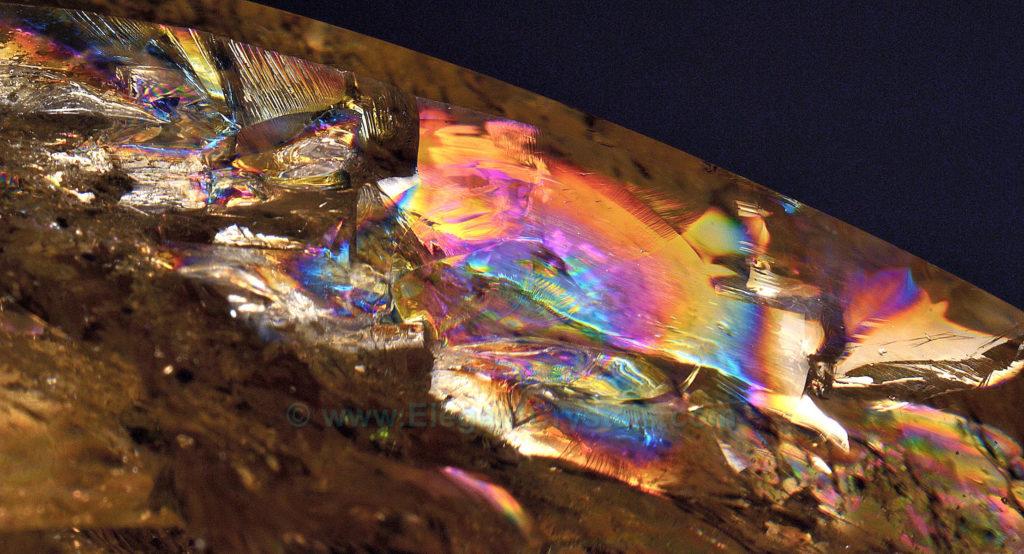
Picture #107
First Order Iris Rainbow in Citrine Quartz
This final photo of the citrine flame features a tiny rainbow system.
This is a complex example because of the folded layers in the fissures showing different types of patterns and colors.
The color scheme is the most rare one found in quartz — purple, orange, gold, and blue with touches of green and white.
It looks like multiple rainbows are stacked in layers under this crystal’s surface.
When the outer surface of a crystal is curved, it magnifies the light, making the rainbows look even larger.
The intensity of colors in quartz is called the “order” of the color.
First-order colors are the brightest and most intense.
Second-order colors are more comprehensive in the range of colors, but less vivid.
Third-order colors are pastel versions of the rainbow.
Fourth-order colors are very faint pastels.
When I photograph rainbows, I find they are so reflective that I have to dim the lights significantly.
Otherwise, the colors appear washed out in the camera’s viewfinder.
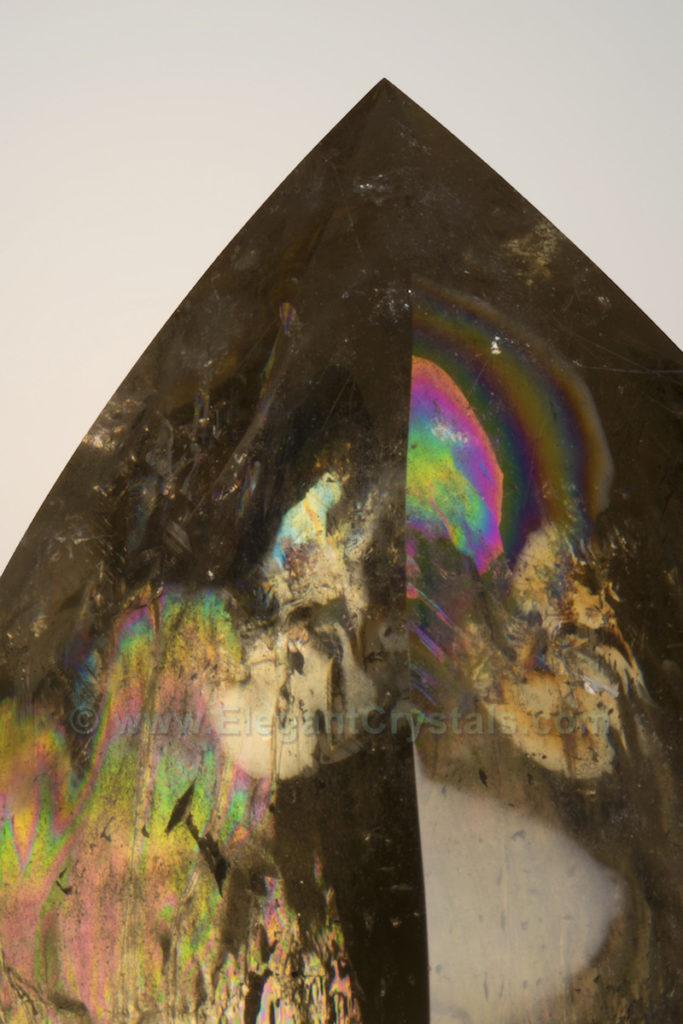
Picture #108
Iris Rainbows in Dark Citrine
Because of these low light levels, the surrounding citrine can appear extremely dark, almost brown or black.
This is an optical illusion that comes from looking at the crystal in a dark room.
Always check your colored crystals under a bright light or outdoors in the sunlight to see the best colors.
While some amethyst and rose quartz may fade in direct sunlight over time, citrine is a mostly stable color.
It is okay to use the power of the sun to energize your natural citrine.
Cooked/heated citrine should not live out doors for long times, as it could fade and bleach out.
The sun’s energy may lessen some of the smoky tint in natural citrine over a period of years.
In a laboratory, smoky citrine can be heated enough so the brown color fades.
This leaves a clear gold color with no grey or tan tint.
This is a dangerous procedure.
If not done in a properly controlled environment, the crystal will crack from temperature changes or mishandling.
Short periods of exposure to sunlight probably will not harm your colored crystals.
You can leave your crystals outside for a matter of minutes or hours.
It is unlikely that the ultraviolet light from the sun will activate the atomic color centers, resulting in a permanent color shift.
There are always exceptions, such as celestite.
Even short exposure to sunlight can cause dramatic color loss in these strontium-silicate stones.
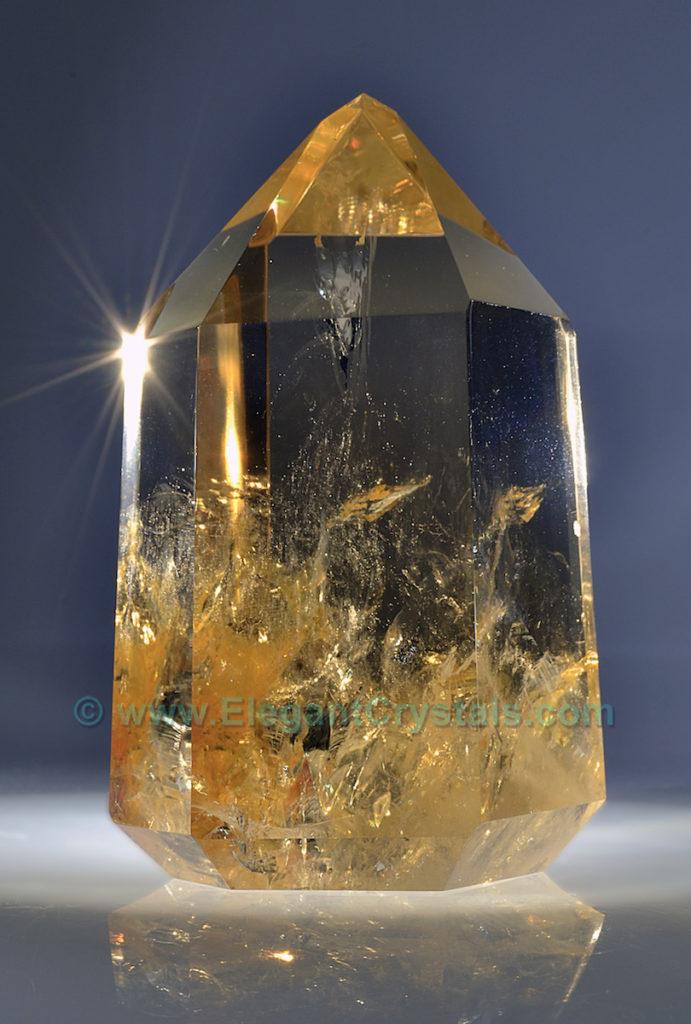
Picture #109
Six-inch-tall Polished Brazilian Citrine Quartz
Crystals do not have to be large to be spectacular.
This six-inch tall polished citrine generator is inherently dramatic with its combination of bright color and extraordinary clarity.
When you first look at a clear crystal, you might not even notice its color.
Because of the clarity at the top of this piece, all you can see is the background color coming through the heart of the citrine.
This background color will look different through the citrine because the gold adds a color shift to the color behind it.
By photographing the stone from a low angle, then tipping the camera backwards to shoot upwards, I can create the impression of a giant crystal even though the stone is small enough to hold in one hand.
This seemingly simple photograph involved five separate light sources to bring out the different highlights and facets of this crystal.
This beveled crystal has 19 facets.
Its complex shape bounces light rays around inside.
When the final light showed as a shining star, I knew that the picture was complete and I could move on to another project.

Picture #110
Three-inch-wide Faceted Brazilian Citrine Gemstone
While most gemstones do not grow to large sizes with any great clarity, citrine is the exception.
This three-inch long sculpture has hundreds of facets cut into an enormous golden jewel.
The clarity is almost perfect.
One or two tiny characteristic quartz inclusions confirm this is a natural stone from the earth.
Upon close examination of this half-pound gemstone, I found very lightly-colored alternating phantom zones of smoky quartz inside the citrine.
One of my customers bought this gem recently (in 2016), and had a startling experience.
When he picked it up for the first time in his left hand, his hand started visibly vibrating from the stone’s energy!
We both watched for a couple of minutes while his hand shook at about three pulses per second.
This was a totally involuntary movement.
When he switched the citrine to his right hand, he could feel the pulsation but not see it.
Back in the left hand, the gem started his flesh shaking again.
I have only seen this happen with two people in my life.
The first time I saw this phenomenon, my friend Neil’s hand and arm were pulsing at 3 separate frequencies!
His hand was moving at one speed; his forearm at a different speed, and his upper arm at a third frequency of motion.
Both his wife and I saw this amazing event, a clear validation of powerful crystal energy effects on the human system.
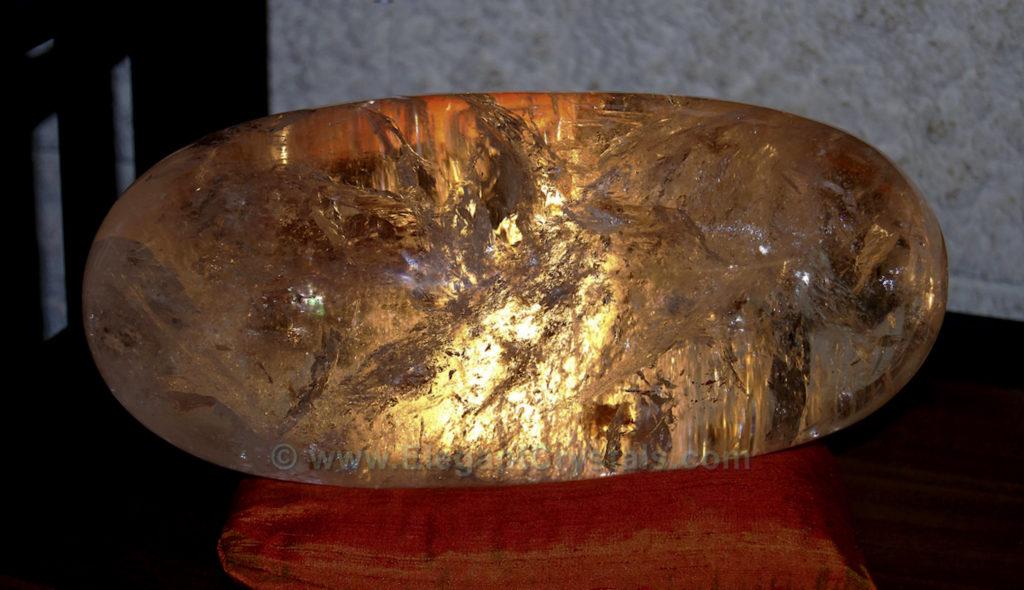
Picture #111
Twelve-inch-long Carved Citrine Lingam Shape from Brazil
This Brazilian citrine crystal was shaped into a sculpture called a lingam.
The lingam shapes originally came from natural stones found in the rivers of India.
The river-tumbled rocks would take on elongated patterns that looked like stretched-out eggs.
Over millions of years, these tumbled stones would be ground down to a fine polish by the surrounding rocks and sand.
Traditionally, this shape from India represented both fertility and prosperity.
The design combines the feminine principle of the egg with the masculine elongation of the phallus.
In the temples of India, childless couples fondle these sacred stones
in the hopes of improving their fertility situation.
A golden citrine lingam seems like a particularly powerful color and shape.
A similar sacred relic was featured in the Indiana Jones film called The Temple of Doom.
When you see the movie, take a look at the glowing golden crystals that were held sacred for thousands of years.
They are the same size and shape as the citrine treasure in the picture above.
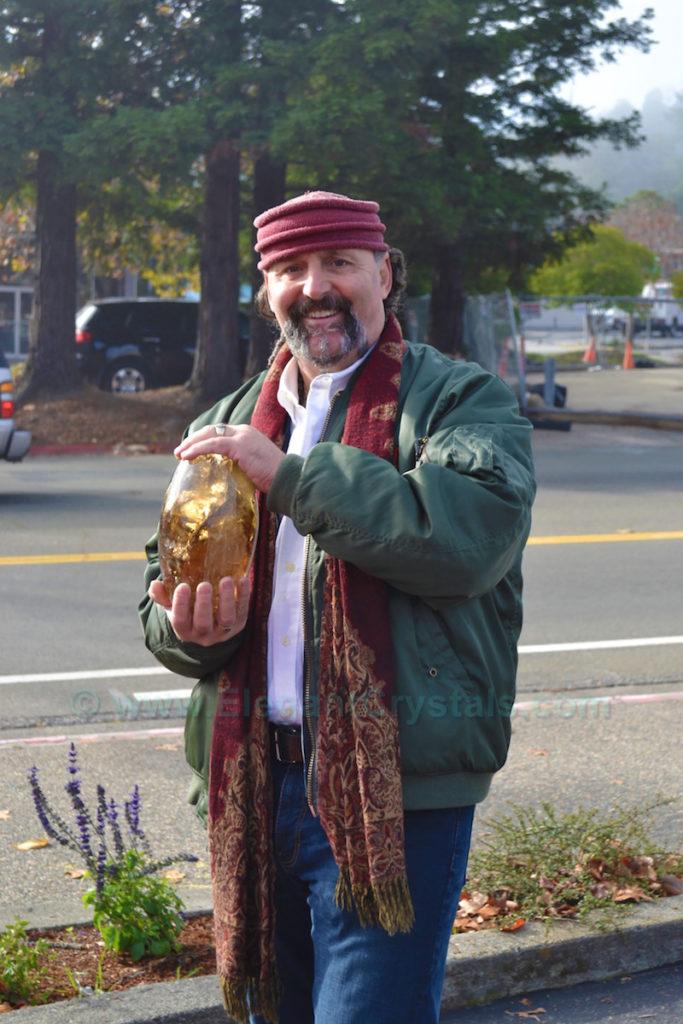
Picture #112
Judson Mayer with His Glowing Citrine Lingam
The man who bought this particular ten-pound stone enjoys it so much that he created a special reinforced pocket for it in his leather jacket.
He always carries around his personal 22,700 carats of citrine.
While this may appear to be a simple shape, the lingam embodies complex curves, challenging for even the most skilled stone-cutters.
This is not really an egg shape at all.
It is more symmetrical with long sides and highly domed ends.
It takes great effort and untold patience to carve a chunk of broken crystal into something so perfectly proportioned.
Inclusions add interest and sparkle because they reflect concentrated light as well as generating rainbow colors at certain angles.
Large colorful, clear stones like this shine beautifully with light bulbs behind them.

Picture #113
60-millimeter-wide Carved Citrine Gem
Cut by Sean Davis and Designed by DaEl Walker
Citrine quartz crystals have been used as gemstones for thousands of years.
An Etowah Indian burial mound in Tennessee yielded a citrine crystal ball that was buried over 4,000 years ago.
The pattern shown here is called a Merkabah.
This one is over two inches wide.
I had it cut from Brazilian citrine, especially thick, to preserve as much color as possible.
As colored stones are sliced thinner and thinner, the color pales until it almost disappears.
Many different kinds of crystals can be cut perfectly flat and then highly polished.
At that point, the front surface is so clear that it is rendered virtually invisible.
The patterns you see inside this crystal are carved and faceted into the back of the stone.
There are 50 highly polished facets in this complex shape.
It was designed to transport people into the energy of the quartz crystal atomic matrix.
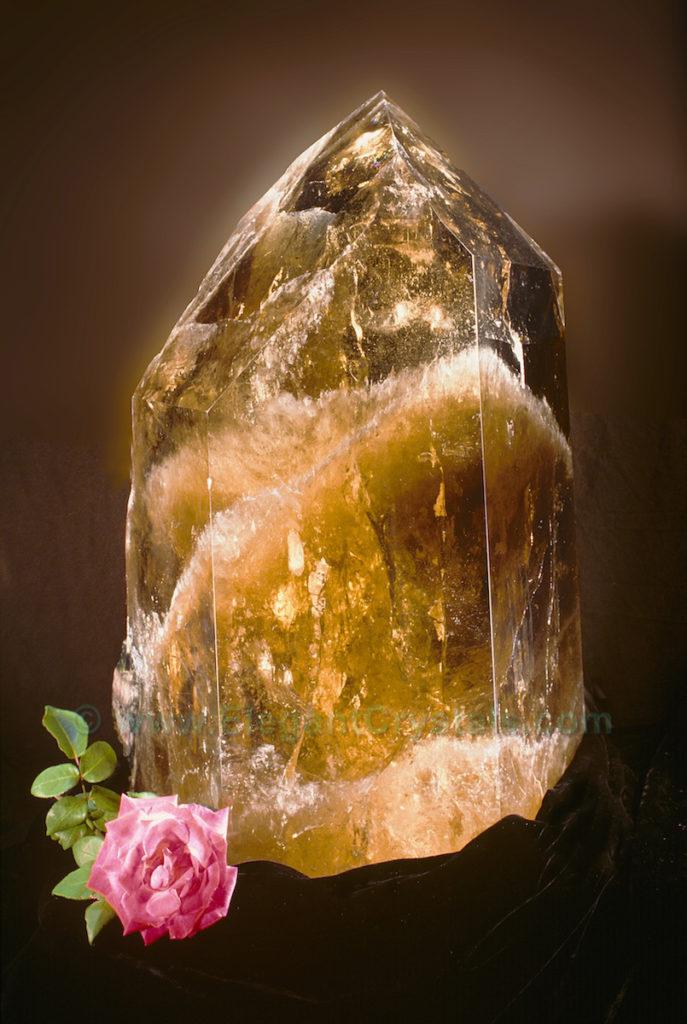
Picture #114
300-pound Polished Citrine from Brazil
Some citrine crystals grow to enormous sizes.
This one is almost three feet tall and 1-½ feet thick.
At two feet wide, it has a huge window for internal visibility.
I have enhanced this stone with lights behind the crystal and in front of it.
The rose in the foreground is immense!
The flower itself is almost six inches wide.
This crystal came from the mines of Brazil and originally had a rough brown crust on it.
Craftsmen polished the huge window facets, except for the base.
We then created a sturdy wooden stand, shaped to hold the stone vertically.
This beautiful, enormously complicated gem now resides in a temple in Thailand.
The veils in the misty interior float into specific zones that create chambers or rooms inside the crystal.
When I was playing around with the lighting, I noticed a lot of highly variable shadows and mysterious spaces inside this huge specimen.
This is the largest citrine crystal I have ever owned, weighing in at some 300 pounds.
In jewelers’ terms that would be 681,000 carats.
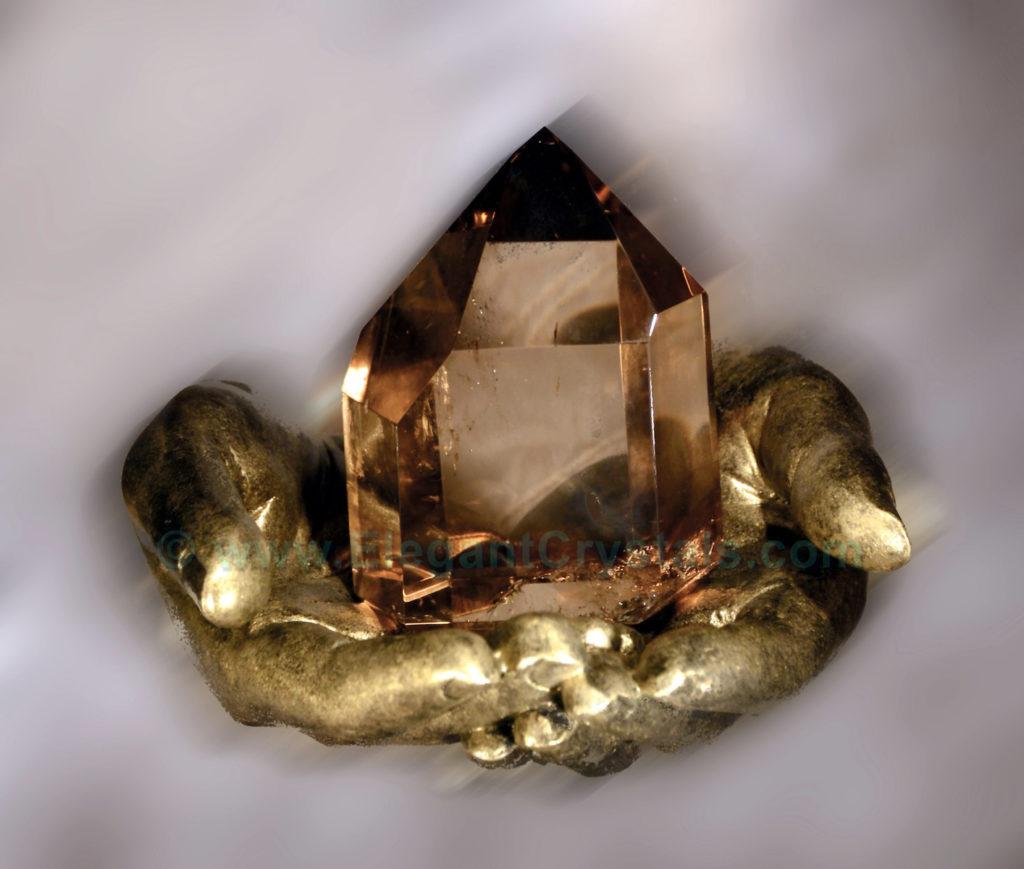
Picture #115
5-inch-tall Optically Clear Polished Citrine Quartz from Brazil
Gem quality citrine is not always yellow or orange in color.
This one is a spectacular deep clear gold color with few inclusions.
Before the base was cut flat, there was a zone of milky quartz that was trimmed away so that light could reach completely through this stone.
I use this life-sized hand sculpture to show the crystal’s size.
Alas, the hands are not made of real gold.
When you look at the background colors through this crystal, you can see the color shift added by the citrine quartz.
The hazy lines around the crystal were added in Photoshop as a way of dramatizing the image.
This is my way of indicating that we are looking at a highly energetic piece of quartz.
The dark facets at the tip of the crystal are not really black.
These are shadows cast by the photographic lighting and would normally appear as deep clear gold.
Quartz is known for creating many optical illusions due to the unusual ways that it transforms light.
Quartz can create and amplify light as well as totally block the perception of light, by reflecting it away from your eyes.
